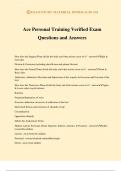©EXAM STUDY MATERIAL 8/9/2024 11:50 AM
Ace Personal Training Verified Exam
Questions and Answers
How does the Saggital Plane divide the body and what actions occur in it? - answer✔✔Right &
Left sides
Flexion & Extension (including dorsiflexion and plantar flexion)
How does the Frontal Plane divide the body and what actions occur in it? - answer✔✔Front &
Back sides
Abduction, Adduction, Elevation and Depression of the scapula, & Inversion and Eversion of the
foot.
How does the Transverse Plane divide the body and what actions occur in it? - answer✔✔Upper
& Lower sides (top & bottom)
Rotation
Pronation/Supination of wrist
Eversion, abduction, inversion, & adduction of the foot
Horizontal flexion and extension of shoulder or hip
Circumduction
Opposition (thumb)
Define the Anatomical Terms:
Medial, Lateral, Proximal, Distal, Superior, Inferior, Anterior, & Posterior - answer✔✔Medial -
toward the midline
Lateral - away from the midline
Proximal - toward attached end/midline/origin
Distal - away from midline
, ©EXAM STUDY MATERIAL 8/9/2024 11:50 AM
Superior - toward head
Inferior - away from head
Anterior - front
Posterior - back
Autogenic Inhibition VS Reciprocal Inhibition (stretch reflex) - answer✔✔Autogenic happens in
the GTO during static stretching. It inhibits the agonist contraction and allows the antagonist to
contract more.
Reciprocal Inhibition happens in the muscle spindle during dynamic stretching. AKA stretch
reflex. It is a reflexive contraction in the against and relaxation in the antagonist.
autogenic - agonist relaxes, antagonist contracts
reciprocal - agonist contracts, antagonist relaxes
Health Related and Skill Related Parameters - answer✔✔Health Related:
Muscular strength and endurance
Flexibility
Body Composition
Cardiovascular/Cardiorespiratory endurance
(aerobic power, mind/body vitality)
Skill Related:
Power, speed, balance, agility, coordination, reactivity
Classification of Body Fat % - answer✔✔Classification Women Men
Essential 10-13% 2-5%
Athletes 14-20% 6-13%
Fitness 21-24% 14-17%
Average 25-31% 18-24%
Obese 32+% 25+%
How to calculate BMI and Classifications - answer✔✔BMI = [Wt (lb) / Ht (in) ^2 ] x 703
, ©EXAM STUDY MATERIAL 8/9/2024 11:50 AM
Underweight = <18.5
Normal = 18.5-24.9
Overweight = 25.0-29.9
Grade 1 Obesity = 30.0-34.9
Grade 2 = 35.0-39.9
Grade 3 = >40.0
SAID Principle - answer✔✔Specific Adaptations to Imposed Demands
The body will adapt to the specific challenges imposed upon it as one as the program
progressively overloads the system. Aerobic can have physiological benefits in 8-12 weeks.
Heat Exhaustion VS Heat Stroke - answer✔✔Heat Exhaustion: Heat Stroke:
Weak, rapid pulse Strong, rapid pulse
Cold/clammy skin Hot, dry skin
< or = 104* > or = 105*
BP lower Bright red
Weakness, paleness Labored breathing
Sweating profusely
Headache, nausea, dizziness
4 Means to reduce body heat - answer✔✔Radiation - heat loss in inferred rays. Transferred with
no physical contact. (we get heat from the sun)
Conduction - transfer of heat into cooler object by touch (hot asphalt into tire)
Convection - transfer of heat to air or water in contact with the body (fan cooling you off)
Evaporation - Transfer of heat from body to sweat then converted to gas
Respiratory Exchange Rate & Percentage of carbs/fat burned - answer✔✔RER Carbs % Fat %
0.70 0 100
0.75 15 85
, ©EXAM STUDY MATERIAL 8/9/2024 11:50 AM
0.80 32 68
0.85 49 51
0.90 66 34
0.95 83 17
1.00 100 0
Joint Types - answer✔✔1. Fibrous - held tightly together by fibrous connective tissue. Little to
NO movement
2. Cartilaginous - connected by cartilage. Little to no movement
3. Synovial - freely moveable.
4 character traits: an articular cartilage and capsule, a synovial membrane and fluid, have
space/joint between them
Movements at joints - answer✔✔Thumb - synovial saddle - flexion, extension, opposition,
abduction, adduction, circumduction
Hip - synovial ball & socket - flexion, extension, abduction, adduction, internal and external
rotation
Knee - synovial modified hinge - flexion, extension, internal and external rotation
Elbow - synovial hinge - flexion and extension
Hand/Foot - synovial condyloid - flexion, extension, circumduction, abduction, and adduction
Shoulder - synovial ball & socket - flexion, extension, abduction, adduction, circumduction,
internal and external rotation
<Eating after Exercise (Glycemic Index) - answer✔✔1.0-1.5g/kg body weight in carbs after
workout within 30 min and again every 2 hours for 4-6 hours.
High GI (>or= 70) foods breakdown faster and lead to greater glycogen stores after exercise.
White bread, corn flakes, graham crackers, dried fruit, instant white rice.
Lower GI (<or= 55)foods are better for weight loss, diabetes, and heart health.
Pumpernickel bread, All Bran, plain yogurt, strawberries, oatmeal.
Med GI (56-69) Rye bread, shredded wheat, ice cream, blueberries, refined pasta.




